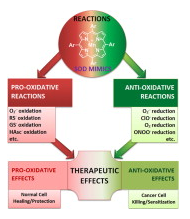To Experienced Mentors,
 My principal investigator (PI) helped me with my writing, the postdocs in lab taught me bench science, and my fellow grad students helped me better communicate my science. I’m going to be in charge of training an undergrad on a project which will be an extension of my dissertation work. I’m excited, and my PI thinks I am ready for this responsibility, but I don’t know if I am going to be good at training as this is my first time as a science mentor. Should I be worried?
My principal investigator (PI) helped me with my writing, the postdocs in lab taught me bench science, and my fellow grad students helped me better communicate my science. I’m going to be in charge of training an undergrad on a project which will be an extension of my dissertation work. I’m excited, and my PI thinks I am ready for this responsibility, but I don’t know if I am going to be good at training as this is my first time as a science mentor. Should I be worried?
Sincerely,
A Nervous New Mentor
Dear A Nervous New Mentor,
First off, congratulations on taking this leadership role in your lab. Training freshmen scientists is one of the most important steps in maintaining the success of not only individual research programs, but scientific progress in general. That being said, training a new lab member as a graduate student or even a postdoc for the first few times can be challenging because rarely will you have someone providing constructive criticism as you employ your own method of training.
Even though this is your first time in a training position, know that your PI trusts you at this point in your career to be able to handle this responsibility. This is not to say there won’t be speed bumps and some additional demands on your already busy lifestyle. But that is where you can utilize your mentors’ help. Never be afraid to ask for advice from your PI and other colleagues who have had the opportunity to train new lab members. Use their advice to mold your own personal training strategy, and over time with trial and error you can improve your mentoring strategy. Even seasoned investigators sometimes have to modify the way they teach based on the available resources and personal characteristics of the trainee.
So to answer your question, don’t be worried. Instead, utilize your skills as a scientist to be observant and know that some hardships and failures may come up that you will have to find solutions to implement.
Sincerely,
An Experienced Mentor (who is still learning a few tricks)
— Published
Categories: Education, Redox Biology
Click here for the full July 2015 edition of SFRBM's DOT Newsletter
DOT: Tell us about your background and current passion in your professional life?
My father was an experimental physicist and I remember watching him assemble a hand blown glass vacuum apparatus to test the hypothesis that led to his graduate degree from the University of Vermont. My own first hands-on laboratory experience outside a classroom was at Argonne National Laboratory where I worked with Dr. Thomas M. Seed on low dose-rate gamma radiation-induced granulocytic leukemia in canines. This led to an interest in radiation biology and cancer and my matriculation to the University of Wisconsin-Madison where I performed graduate studies in the Human Oncology department under the mentorship of Dr. Kelly H. Clifton. My graduate training was in classical cellular radiation biology and carcinogenesis with a strong emphasis on organismal physiology and endocrinology. Since ~70% of the biological effects of gamma and x-ray irradiation are mediated through the radiolysis of water to generate oxygen free radicals, a natural interest in free radical processes in biology and medicine was forged from this background. I furthered my training at the post-doctoral level pursuing studies in molecular biology, carcinogenesis and redox-signaling at the University of Arizona Cancer Center in the laboratory of Dr. G. Tim Bowden. In 1993 I joined the University of Iowa and was fortunate to work as a colleague of Dr. Larry W. Oberley for 15 years until his untimely death in 2008. His inspiration helped crystalize for me a vision for how cellular redox metabolism communicates with epigenetic writer and eraser enzymes which when perturbed lead to aberrant epigenetic marks observed in tumor cells. I have pursued this general concept and many other side projects during my 23 year tenure at The University of Iowa. The current passion in my professional life is to watch the professional and career development of my numerous trainees from over the years unfold as they become successful in their own independent research careers and carry the torch of knowledge forward to the next generation.
 |
|
Rick Domann, Ph.D. |
DOT: Briefly describe your research interest and what is the most notable research achievement from your lab?
My research interests are in redox signaling, metabolism, cancer and epigenetics. I seek to understand how long-term perturbations to normal redox homeostasis such as those that occur in pathologies are drivers of an altered epigenetic landscape that changes phenotype without changing genotype. The most notable achievement from our lab has been the discovery that unfolded over the last five years which is that the SOD3 gene that encodes the extracellular superoxide dismutase is a potent metastasis suppressor gene and that its loss in several human epithelial cancers causes an acceleration of disease progression and a decrease in metastasis-free survival. This is in part due to the potent anti-inflammatory effects of EcSOD; its absence allows the proliferation of free radical reactions that degrade and destroy sensitive ECM components and accelerate invasion and metastasis.
DOT: Who has been your greatest teacher? What do you think the most important factors that shaped your career?
This is a difficult question to answer because there were and still are several very important mentors in my life, and it is nearly impossible to select the ONE that has had the most influence. I’d have to say that looking back at the direction of my work and the publications resulting over the last 30 years that my most influential teachers and mentors were Kelly Clifton and Larry Oberley.
DOT: In the current climate in which investigators are faced with decreased NIH funding for research and low morale, what is the best advice?
There is always room for optimism, and recent reports are that NIH may get a long-needed boost in support from Congress. Newt Gingrich recently wrote an Op-Ed in the New York Times (Apr 21, 2015) calling for another doubling of the NIH budget, and in mid-May the U.S. House of Representatives released a draft bill that aims to increase the NIH budget by $10 billion over 5 years. These shifting winds mean that investigators should stay tuned for additional evolving opportunities. Your Society leadership is trying to bring awareness to the field of redox biology and medicine at the NIH and other federal granting agencies by bringing scientific review administrators and program officers to the annual meetings to hold workshops for our members and highlight recent trends and funding opportunities in our field.
DOT: Being a mentor, you have shaped many students (graduate and postdoc) to enter academic and industry research, any tips how to shape individuals for these scientific fields?
There is no substitute for assiduity and a solid work ethic; being present is the greatest part of success. Beyond that, astute observational and critical thinking skills are required in a scientific profession of any kind. In addition, organizational, time management, and effective interpersonal communication are all key elements to success in science. I believe that proposals and reports need be compiled in a technically accurate manner and written in cogent prose in both academic and industry roles, so I think at least at the graduate training level there is little difference in how I would prepare them. At the post-doctoral level, a postdoc interested in industry may test the waters first by doing an industry post-doc or internship.
DOT: What do you think is the direction the Oxidative Stress field is heading?
Interesting question… I think that life is stress, especially life in an oxygen rich world. Thus all living organisms are in a non-steady state equilibrium that oscillates around various levels depending upon physical, biological, and environmental cues. A normal state of existence might be thought of as “eustress”, which is a normal and good part of life that is hormetic and that allows for rapid adaptive responses in either direction to maintain cell and tissue redox balance. Additionally, there is finally a realization in the community that redox sensors have been frequently misconstrued as antioxidant defenses when in many cases they are in fact signal transducing modules. All major disease of mankind possess an oxidative stress component to their pathologies, and so in order to cure these disease a deeper understanding of the redox signaling relays evolved in life in oxygen is needed.
DOT: And in the other direction, translational research.
Translational research utilizing basic knowledge learned from redox biology is growing exponentially. The role of free radicals and redox biology in inflammation, cancer, diabetes, cardiovascular and pulmonary diseases is well appreciated. Now, pharmacological control of certain of these systems is well in hand and drugs that mimic SOD activity are in clinical trials. Also, the paradoxical pro-oxidant effects of high dose vitamin C are making a big comeback in cancer clinics nationally with promising results using high C as an adjuvant for traditional therapies with no notable toxicity. Also, the role of redox couples that sense and signal oxidative stress, such as NADH/NAD+ are found to be vitally important for aging and cancer by altering the activity of sirtuin family enzymes, and oral nicotinamide was recently found to provide significant protection from non-melanoma skin cancer in high risk people. These are just a few examples of a growing list of medical applications forged from the furnace of free radical biology.
DOT: How has science/research changed during your life as a scientist?
I finished my BS in Biology in 1983, started grad school in 1984, and PCR was invented in 1985. That single method revolutionized experimental biology. In 1998 endothelial-derived relaxing factor was discovered to be nitric oxide which led to the Nobel Prize for scientists working in the field of free radical biology. I’ve always thought it was curious that the work on NO led to a prize, but the discovery of superoxide in biological tissues by Fridovich and McCord didn’t, especially since this was the seminal finding that gave birth to the field of free radical biology. The human genome initiative was completed by 2003; before that the GenBank was a fairly primitive and barely searchable database. The complete sequencing of many human genomes and the associated browser capability to navigate the human genome has changed everything about the future of medicine. Through that process, advances in DNA sequencing technology and speed have exceeded all expectations and has improved faster than Moore’s law. This is enabling an unprecedented examination of human microbiomes, genetic heterogeneity of cancer, even identifying heritable disease genes of embryos in utero from non-invasive blood tests of the mother. Finally, and directly relevant to mitochondrial redox biology, the United Kingdom recently approved the “three-parent baby”, which is aimed at eradicating familial mitochondrial diseases.
DOT: How important is the SFRBM conference to you and your trainees? Being elected as the president, what are the ideas are you planning for this society?
The annual SFRBM meeting has always been an extremely important meeting for me and my trainees. I have attended every meeting but one since 1994 and have usually travelled with a small entourage of trainees. The annual meeting has been important to me because it has allowed me to showcase my lab’s work in a receptive and like-minded audience. My trainees have been frequently selected for talks and awards and have benefited enormously from their sustained involvement in the Society. The Society is at a crossroads now, many members believe that it is time to re-brand and become more inclusive of all redox biology rather than exclusive to free radicals. Membership has been declining over the last few years and it is time to reinvigorate and re-energize the Society with an infusion of fresh blood that can most effectively be accomplished by broadening the scope and appeal of the Society to a wider scientific audience, one that would encompass and embrace all relevant redox biology in pathology and medicine. I have met personally with members of the membership committees and they are working with me on proactive strategies to not only retain existing members but also to recruit new members from all possible avenues. I believe that our new membership in FASEB will help in this regard, but also our Society would benefit from becoming more proactive at recruiting new members from like-minded scientists in other professional societies.
DOT: What are your hobbies outside the laboratory?
I enjoy reading, music, cooking, biking, traveling, hiking, fishing, & downhill skiing. I walk my dogs daily and always strive for at least ten thousand steps per day on the pedometer!
— Published
Category: SfRBM Member Profile
Click here to view the complete article in Redox Biology
Most of the SOD mimics thus far developed belong to the classes of Mn-(MnPs) and Fe porphyrins(FePs), Mn(III) salens, Mn(II) cyclic polyamines and metal salts. Due to their remarkable stability we have predominantly explored Mn porphyrins, aiming initially at mimicking kinetics and thermodynamics of the catalysis of O2− dismutation by SOD enzymes. Several MnPs are of potency similar to SOD enzymes. The in vivo bioavailability and toxicity of MnPs have been addressed also.
 Numerous in vitro and in vivo studies indicate their impressive therapeutic efficacy. Increasing insight into complex cellular redox biology has been accompanied by increasing awareness of complex redox chemistry of MnPs. During O2− dismutation process, the most powerfulMn porphyrin-based SOD mimics reduce and oxidize O2− with close to identical rate constants. MnPs reduce and oxidize other reactive species also (none of them specific to MnPs), acting as reductants (antioxidant) and pro-oxidants.
Numerous in vitro and in vivo studies indicate their impressive therapeutic efficacy. Increasing insight into complex cellular redox biology has been accompanied by increasing awareness of complex redox chemistry of MnPs. During O2− dismutation process, the most powerfulMn porphyrin-based SOD mimics reduce and oxidize O2− with close to identical rate constants. MnPs reduce and oxidize other reactive species also (none of them specific to MnPs), acting as reductants (antioxidant) and pro-oxidants.
Distinction must be made between the type of reactions of MnPs and the favorable therapeutic effects we observe; the latter may be of either anti- or pro-oxidative nature. H2O2/MnP mediated oxidation of protein thiols and its impact on cellular transcription seems to dominate redox biology of MnPs. It has been thus far demonstrated that the ability of MnPs to catalyze O2−dismutation parallels all other reactivities (such as ONOO− reduction) and in turn their therapeutic efficacies.
Assuming that all diseases have in common the perturbation of cellular redox environment, developing SOD mimics still seems to be the appropriate strategy for the design of potent redox-active therapeutics.
— Published
Categories: Education, Redox Biology
By: Kelly K. Andringa, PhD, MBA, University of Alabama at Birmingham Division of Nephrology Program Manager
 As Michelle mentioned last month you don’t want to be nearing the finish with your postdoc (or perhaps even your graduate training) without having a career goal or target in mind. These goals and targets can change, but you should have some idea where you’d like to start. Sometimes these goals aren’t the same as your mentors and you might not have any idea exactly how to get where you want to go. This is where you need an active network (something else Michelle mentioned) to help you out.
As Michelle mentioned last month you don’t want to be nearing the finish with your postdoc (or perhaps even your graduate training) without having a career goal or target in mind. These goals and targets can change, but you should have some idea where you’d like to start. Sometimes these goals aren’t the same as your mentors and you might not have any idea exactly how to get where you want to go. This is where you need an active network (something else Michelle mentioned) to help you out.
Networking is discussed ALL the time as the vital part of any career path, not just science. If your career aspirations take you away from the traditional academic faculty track you will need to reach out and talk to others who have those roles you’re interested in. “Alternate careers” is a phrase that gets thrown around a lot. The statistics about obtaining an academic faculty position look daunting (see this video from Dr. Sally Rockey about the average age of faculty and R01 PIs in academia over the last 20+ years) and lead people to think about exploring other options. Now, let me be clear, I thoroughly enjoy my “alternate career,” it is in no way my “back up plan.” I haven’t taken the positions I have after my postdoc because I was discouraged from being faculty, I went into this career path fully aware of what I was getting into and what I was giving up. I definitely think that careers in academic research are possible and people who want them should absolutely go for them. I am not that person.
During my graduate training I had 5 projects going, I needed a bit of help narrowing my focus. About the time of my qualifying exams, my mentor and I had a good sit down about my career goals and aspirations. Although I had initially gone to graduate school with the goal of running my own lab and working on more tolerable therapeutics for cancer treatment, I had started to realize I had skill sets that would be better utilized outside the lab. Fortunately, my graduate and postdoctoral mentors were open to those discussions about careers outside of academic faculty positions. Thankfully, I’m reasonably willing to talk about the things I want/need regardless of the outcome, but not everyone has mentors that are supportive of other career paths. Luckily, Science Careers (sponsored by AAAS) has an online IDP (Individual Development Plan) to help you determine your interests and get them down ‘on paper’ so you have a career plan going forward that you can modify and discuss.
Clearly, there are a number of “alternate careers” out there and I’m hoping there will be more blog posts about some of the other ways people utilize their PhD’s outside of academia. I can only speak to my area of interest, I’m in Research Administration. What do I do every day?? Well my daily tasks are varied and no day is the same. I’m currently a Program Manager at the University of Alabama at Birmingham. I assist in the management of a multi-institution P30 grant that has three research areas with about 7 different core facilities involved with those areas. There is also a pilot grant program as well as educational components for seminars, workshops and training experiences. I also assist in the management of an NRSA postdoctoral training grant that currently funds 5 trainees, plus a number of other tasks for my boss and my division. Here is what I enjoy most about my job; I get to talk about all different kinds of science and research with so many different people. I help direct faculty interested in utilizing our core facilities to the correct people, I get to read about new and exciting research directions via the pilot studies proposed, and watch young scientists transition their careers where they want to go, it’s great. I do miss the bench work, but I think my skills are best utilized in helping others reach their scientific research goals.
So how did I get here? We have to take it back to networking, as Glinda told Dorothy; you’ve had the ability all along you just wouldn’t have believed me. In those original discussions with my graduate mentor, he mentioned that one of his classmates from graduate school was a program officer at NIH. He sent her an email asking if she would be willing to talk to me about her career and what her job entailed. Here’s a hint, informational interviews are a great way to connect with people who have jobs you’re interested in. This is not a time to pester them to get you a job or pass around your CV, this is informational, you are inquiring about their job, how they got there and what they do on a daily basis. I sent a number of emails and had friends send emails to people who had jobs I was interested in learning about. I talked to program officials at NIH, associate vice presidents of small and large universities, directors of sponsored programs, program managers from my university and others in compliance offices (IRB, IACUC etc.) about their jobs. Networking is important, don’t be pushy, and ask when a good time is to call. Have a number of questions ready but don’t plan to take up more than 30 minutes of their time (maybe less), they can make it go longer but you shouldn’t be the one keeping them on the phone for hours, they’re busy and you want them to remember you were sensitive to their time.
So you’re likely thinking, great advice Kelly, but does it really work? In fact yes, it does work. One of those informational interviews I had was with someone who also had transitioned from a postdoc to grants management. A year after I spoke with her, her division was looking for someone to manage and ARRA funded multi-site project. She contacted me to see if I was still interested in administration and if I would like to interview for the job. So see, making a good impression while learning about someone else’s job got me an “in” for an interview. Networking won’t necessarily get you the job. Your education, training, and knowledge will get you the job; networking can help get you in the door.
— Published
Category: Education
By: Michelle Booze, Postdoctoral Fellow, Children’s Health Research Center at Sanford Research - @DrMLBooze, @sanfordhealth
This past March I had the opportunity to attend the National Postdoctoral Association (NPA) 2015 Annual Meeting. What I learned there helped me to focus on my future as a scientist. Are you getting the career help you need to determine your future? Luckily, there is a wealth of information out there to help you along your journey. The following are 5 rules to get you started down the right path to your dream career.

Rule #1: Don’t be this person
This information was presented by Sarah Cardozo-Duncan (@sarahcarstrat) and James Gould (@HMSpostdoc) during a workshop at the meeting. It is important not to be the person who:
Rule #2: Know what you want to do with your degree
It is very important that you take time to think about where you want to be in your future. It’s never too late to figure this out and start pursuing your goal. Don’t set unrealistic goals, but don’t hold back either or you might not reach your full potential!
Rule #3: Find a valuable mentor
If you want your PI’s/Advisor’s/Boss’s job, then they are the right target for a mentor. If you want a different position, find another mentor. There are a ton of resource materials on nurturing a successful mentor relationship. Look to the societies you’re involved in, such as SFRBM, for help.
Rule #4: Make connections
An informational interview is all about getting to know someone and the place they work (and sharing a little bit about yourself too!). It’s not about flinging your CV at them (although you should have a copy ready to fling). There’s a nice entry about the Informational Interview here - http://thepostdocway.com/content/michelles-corner.
Rule #5: Know your Resources
There are a myriad of great web sources at our disposal to take advantage of.
Remember, your future is up to you. It is your responsibility to reach your own goals.
— Published
Category: Education